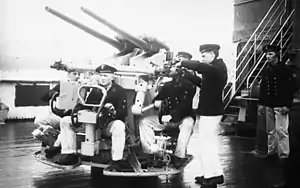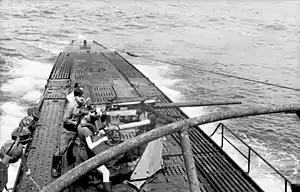| 3.7 cm SK C/30 | |
|---|---|
 3.7 cm SK C/30 on a Dopp L C/30 stabilized mount | |
| Type | Anti-aircraft cannon |
| Place of origin | Nazi Germany |
| Service history | |
| In service | 1935–1966 |
| Used by | Nazi Germany Spain |
| Wars | Second World War |
| Production history | |
| Designer | Rheinmetall |
| Designed | 1930–1935 |
| Manufacturer | Rheinmetall |
| Produced | 1935–1943 |
| Variants | 3.7 cm SK C/30U |
| Specifications | |
| Mass | 243 kilograms (536 lb) |
| Length | 3.074 metres (10 ft 1 in) |
| Barrel length | 2.962 metres (9 ft 9 in) L/83 |
| Shell | fixed, cased charge |
| Shell weight | 0.68 kilograms (1 lb 8 oz) |
| Caliber | 37 x 380 mm R |
| Action | single-shot |
| Breech | semi-automatic, vertical sliding-block |
| Elevation | depends on the mount |
| Traverse | 360° |
| Rate of fire | 30 rpm (practical) |
| Muzzle velocity | 1,000 m/s (3,300 ft/s) |
| Effective firing range | 2,000 m (6,600 ft) (effective ceiling) |
| Maximum firing range | 8,500 m (9,300 yd) at 37.5° |
The 3.7 cm SK C/30[Note 1] was the German Kriegsmarine's primary 3.7 cm (1.5 in) anti-aircraft gun during the Second World War. It was superseded by the fully automatic 3.7 cm FlaK 43 late in the war.
Description
The C/30 was a semi-automatic anti-aircraft gun (ie; after firing each round, the breech opened and the spent cartridge casing was automatically expelled, ready for the next round to be loaded), and it was hand-loaded one round at a time. This mechanism gave the weapon an effective, sustained, firing rate of 30 rounds per minute. Whilst not uncompetitive with contemporary and earlier designs of semi-automatic light gun, it was far inferior to the 120 rpm cyclic firing rate of its (slightly later-designed) wartime contemporary, the fully automatic Bofors 40 mm anti-aircraft gun. The C/30's muzzle velocity was, on the other hand, about 12-15% higher than the Bofors; this slightly eased the aiming. The SK C/30U gun was modified for use by submarines. All mountings were suitable for use against both air and soft surface targets.[1]
Ship classes that carried the 3.7 cm SK C/30 include:
- Admiral Hipper-class cruisers
- Bismarck-class battleships
- Chamois-class minesweeping sloops
- Deutschland-class battleships
- Deutschland-class cruisers
- Elbing-class torpedo boats
- F-class escort ships
- German Type IXA submarines
- German Type XIV submarines
- Graf Zeppelin-class aircraft carriers
- Königsberg-class cruisers
- Leipzig-class cruisers
- M-class minesweepers
- PA-class patrol ships
- R boats
- Sperrbrecher
- Scharnhorst-class battleships
- Type 1934A-class destroyers
- Type 1936-class destroyers
- Type 1936A-class destroyers
- Type 1936B destroyers
- Type 35 torpedo boats
- Type 37 torpedo boats
Mountings

The Doppellafette C/30 (Dopp L C/30) was a twin mount with each gun in a separate cradle. It had a six-man crew on the mount itself plus additional ammunition handlers. The mounting was manually traversed and elevated and was gyro-stabilized up to a limit of 19.5° degrees to counteract the roll and pitch of the ship. Most German ships, fleet torpedo boat or larger, carried at least one Dopp L C/30 mounting. The Einheitslafette C/34 (Einh L C/34, universal mounting model 34) was a single gun mounted on a pedestal with a two-man crew. Some mounts were fitted with a 8-millimetre (0.31 in) gun shield. It was used on the smaller Kriegsmarine ships like the Schnellboot. A number were used on land to supplement the anti-aircraft defenses of ports. The Ubts L C/39 submarine mount used the SK C/30U gun. It was a simple pedestal mount with a two-man crew, one of whom trained the gun with the shoulder stirrup; the other used gears to elevate the gun.[2]
| Mounting | weight | elevation |
|---|---|---|
| Dopp L C/30 | 3,670 kg (8,090 lb) | -9° to +85° |
| Einh L C/34 | 1,860–2,020 kg (4,100–4,450 lb) | -10° to +80° |
| Ubts L C/39 | 1,450 kg (3,200 lb) | -10° to +90° |
Ammunition
The SK C/30 used two types of tracer rounds. The 3.7 cm Br Sprgr Patr 40 L/4.1 Lh 37M was a high-explosive round with an incendiary filling while the 3.7 cm Sprgr Patr 40 L/4.1 Lh 37 lacked the incendiary fill, but was otherwise identical. Tracers were available in red, yellow or white and were marked on the shell by a painted band of the appropriate color. A complete round weighed 1.78 kilograms (3.9 lb).[3]
Comparison of anti-aircraft guns
| Country | Gun Model | RPM | Projectile Weight | Weight of fire |
|---|---|---|---|---|
| 3.7 cm SK C/30 | 30 | .74 kg (1.6 lb)[4] | 22.2 kg (49 lb) | |
| Canon de 37 mm Modèle 1925 | 15–21 | .72 kg (1.6 lb)[5] | 10.8–15.12 kg (23.8–33.3 lb) | |
| Cannone-Mitragliera da 37/54 (Breda) | 60–120 | .82 kg (1.8 lb)[6] | 49.2–98.4 kg (108–217 lb) | |
| 37 mm Gun M1 | 120 | .87 kg (1.9 lb) | 104.4 kg (230 lb) | |
| 3.7 cm Flak 18/36/37/43 | 150 | .64 kg (1.4 lb)[7] | 96 kg (212 lb) | |
| 37 mm automatic air defense gun M1939 (61-K) | 80[8] | .73 kg (1.6 lb)[9] | 58.4 kg (129 lb) | |
| QF 2-pounder naval gun | 115 | .91 kg (2.0 lb)[10] | 104.6 kg (231 lb) | |
| Bofors 40 mm gun | 120 | .9 kg (2.0 lb)[11] | 108 kg (238 lb) |
Footnotes
- ↑ SK - Schnelladekanone (quick loading cannon); C - Construktionsjahr (year of design)
Citations
- ↑ Campbell, p. 256
- ↑ "German 3.7 cm/L83 (1.5") SK C/30 3.7 cm/L83 (1.5") SK C/30U". 23 March 2009. Retrieved 11 June 2009.
- ↑ Hogg, p. 223
- ↑ DiGiulian, Tony. "Germany 3.7 cm/83 SK C/30 - NavWeaps". www.navweaps.com. Retrieved 7 June 2017.
- ↑ DiGiulian, Tony. "France 37 mm/50 (1.46") Model 1925 and CAIL Model 1933 - NavWeaps". www.navweaps.com. Retrieved 7 June 2017.
- ↑ DiGiulian, Tony. "Italy 37 mm/54 (1.5") Models 1932, 1938 and 1939 - NavWeaps". www.navweaps.com. Retrieved 7 June 2017.
- ↑ DiGiulian, Tony. "Germany 3.7 cm/57 (1.5") Flak M43 - NavWeaps". www.navweaps.com. Retrieved 7 June 2017.
- ↑ Foss, Christopher (1977). Jane's pocket book of towed artillery. New York: Collier. p. 229. ISBN 0020806000. OCLC 911907988.
- ↑ DiGiulian, Tony. "Russia / USSR 37 mm/67 (1.5") 70-K - NavWeaps". www.navweaps.com. Retrieved 7 June 2017.
- ↑ DiGiulian, Tony. "United Kingdom / Britain 2-pdr QF Mark VIII - NavWeaps". www.navweaps.com. Retrieved 7 June 2017.
- ↑ DiGiulian, Tony. "USA Bofors 40 mm/60 Model 1936 - NavWeaps". www.navweaps.com. Retrieved 7 June 2017.
References
- Campbell, John (2002). Naval Weapons of World War Two. London: Conway Maritime Press. ISBN 0-87021-459-4.
- Gander, Terry; Chamberlain, Peter (1979). Weapons of the Third Reich: An Encyclopedic Survey of All Small Arms, Artillery and Special Weapons of the German Land Forces 1939–1945. New York: Doubleday. ISBN 0-385-15090-3.
- Hogg, Ian V. (1997). German Artillery of World War Two (2nd corrected ed.). Mechanicsville, PA: Stackpole Books. ISBN 1-85367-480-X.
- Stehr, Werner (1999). Leichte und mittlere Artillerie auf deutschen Kriegsschiffen [Light and Medium Artillery on German Warships] (in German). Wölfersheim-Berstadt: Podzun-Pallas-Verlag. pp. 8–11. ISBN 3790906646.